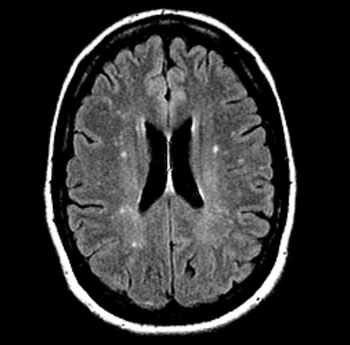MRI Study Shows Migraines with Aura Unrelated to Brain Anomalies
By MedImaging International staff writers
Posted on 19 May 2016
A new magnetic resonance imaging (MRI) study found no association between silent brain infarcts or white matter hyperintensities (WMHs) and migraines with aura.Posted on 19 May 2016
Researchers at Odense University Hospital (OUH; Denmark) and the University of Southern Denmark (SDU; Odense, Denmark) conducted a population-based study to identify the relationship between silent brain infarcts, WMHs, and migraine. Via the Danish Twin Registry, they identified 172 twins (30-60 years of age) with migraine with aura and 34 co-twins who, unlike their participating twin sisters, did not suffer from migraine with aura. A further 139 twins served as controls.

Image: Increased white matter in migraine headache (Photo courtesy of Medscape).
Based on questionnaire responses, the twins were invited to participate in a telephone-based interview. Women with migraine with aura, their co-twins, and unrelated migraine-free twins were invited to a brain MRI scan, which was assessed for the presence of infarcts and WMHs, and blinded to headache diagnoses. The results showed no differences between women with migraine with aura and those without, with regard to number of silent infarcts and WMHs. The study was published on May 3, 2016, in Brain.
“We found no evidence of an association between migraine with aura and silent brain infarcts or white matter hyperintensities,” said lead author David Gaist, MD, of OHU and SDU. “This held true for the main analyses comparing cases with unrelated controls, and for analyses focusing on twin pairs where one twin suffered from migraine with aura, and the other did not. We believe patients suffering from migraines with aura and their physicians should find these results reassuring.”
Migraine is a common disorder afflicting about 10–15% of the population. One-third of migraineurs experience transient neurological symptoms known as auras. Population-based studies have indicated that migraine, and in particular migraine with aura, may be a risk factor for subclinical (silent) brain infarcts and WMHs, which have been associated with an increased risk of stroke, dementia, and death. This raised the question whether migraine, a condition so common as to be encountered by all physicians regardless of specialty, is a chronic progressive brain disorder.
Related Links:
Odense University Hospital
University of Southern Denmark










 Guided Devices.jpg)



